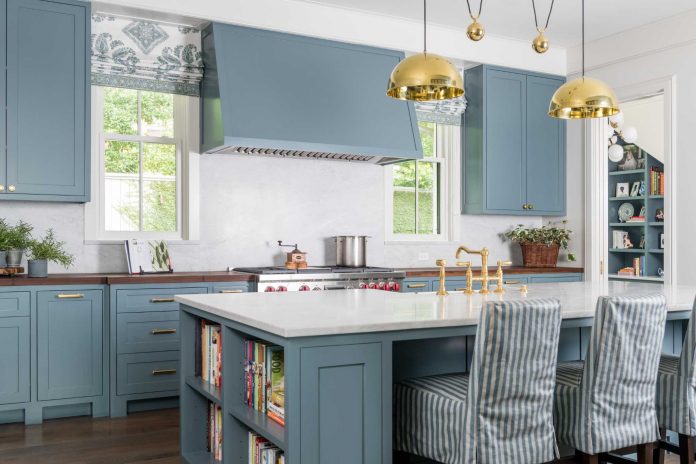They tuck into the ceiling or hide behind a valance or even draperies, and they’re a go-to décor item for any style home. They come ready-to-hang, semi custom or even custom made and they can work just fine by themselves or paired with draperies.
“Window treatments complete a room. They are the architecture of decorating,” said interior designer Linda Eyles of Linda Eyles Design in Houston. “If there’s a beautiful view, the window treatment becomes more important to frame the view. It gives structure, it gives height and yet it also gives a lot of softness and depth.”
Anyone who’s bought or built a new house has struggled with the decisions of whether to use draperies or not — or whether to use Plantation-style shutters, blinds or roller, cellular or Roman shades.
The style and mood of a room dictate what you should put on your windows, Eyles said.
Tips for buying and hanging draperies
Hang the rod: Designers disagree on how high to place a curtain rod, but all agree it should be at least 4 to 6 inches above the window frame. Some designers go higher than that; others go nearly to the ceiling. The rod should be 8 to 12 inches wider than your window (4 to 6 inches on each side).
Width:Don’t skimp on fabric. The width of your drapery panels should be 2 to 2 ½ times wider than your window to have the right fullness. If you only want your draperies to frame the window, they should be 1 ½ times the width of the window.
Length: Draperies should hang about a half inch or less above the floor. Puddling draperies — leaving several inches of fabric on the floor — is stylish now but comes with maintenance such as frequent cleaning and refluffing.
Fabric: Lighter, loosely woven fabrics give a more casual look; conversely, fabrics like velvet will feel darker and heavier.
Print vs. solid:A room with patterns on furniture, bedding and rugs likely calls for solid curtains. If you room is plainer, with few to no prints, feel free to use a print in curtains.
Sources: realsimple.com;
apartmenttherapy.com
“I don’t always use draperies, but I prefer them if the room calls for it. We keep them simple, operable panels with a nice, clean modern rod and some rings. I have to say I actually think that more draperies are coming back,” said Eyles, who insists that draperies be operable rather than fixed panels that never move.
“We layer a lot. We’ll do a grass shade with drapery over it, that’s one of my favorite looks and it gives people a lot of options for what to do with window treatments,” she said. “I do love the look, but we also have a couple of modern jobs with nice clean shades on the windows.”
For Cathy Robinson Hutton of the Renovate décor and design store, also in Houston, shades are the way to go, unless a room really needs something to soften it.
Draperies are high maintenance. They hold dust,” Robinson Hutton said. “Here in the store, our housekeeper takes them outside and beats them like a rug to get the dust out.”
In many contemporary or modern homes, windows aren’t just something to look through — they’re architectural elements integral to the design of the home. Often used in large-scale spaces, they still need something to keep harsh UV rays out, and solar shades — automated versions that can be designed to tuck up into the ceiling — are common options.
Tyler Spaulding, who opened his Houston Shutter Center 15 months ago, said that window shades and shutters are popular because they’re functional and often add value to your home.
Cellular and solar shades work well for windows that take a lot of sunlight, and wooden blinds remain popular with his customers. For Plantation-style shutters, Spaulding cites larger louvres — 3.5-inch to 4.5-inch wooden wooden slats instead of 2.5-inch ones — as well as placing the tilt rod on the back of the shutter, as new trends.
Spaulding and Adam Skalman, vice president of sales for The Shade Store, both said roller or solar shades have some important features for Texas homes: keeping out up to 99 percent of UV rays and making your home more energy efficient. And improved fabrics and other materials means they can look good for a decade or more.
Technological improvements mean that fabrics and materials are more durable and more attractive, Skalman said, but on the tech side, it means automated shades are getting more affordable.
“We’ve invested a lot of time, energy and technology to develop a motorization program that’s easy to use, order and operate. It doesn’t require a lot of electrical work and lasts a long time,” said Skalman. “We have battery-operated motors and they can operate shades up to 12 feet wide. It’s plug and play.”
While automated shades aren’t the least expensive option , prices have come down. Skalman said that for a standard size window, a roller shade starts at around $200, then add another $350 for the motor.
Spaulding said that among his inventory, a 36-by-60-inch automated shade that would have cost $600 a few years ago now costs about $400.
As prices continue to drop, Spaulding thinks more people will get on board. In fact, he believes that in 10 years, one in three windows will be automated.
Functionality aside, many people focus on the aesthetic. Some opt for patterns from designers like Jonathan Adler or Nate Berkus, both of whom have collections with The Shade Store.
“If people are moving into a new home or are not confident in design choices, they go with a neutral in a way that’s exciting and not mundane,” Skalman said. “At the end of the day, it’s an investment. People think about resale value and window treatments are a great way to increase it. But we love any customer who wants to go down the road of a patterned shade. Those are always fun.”





































